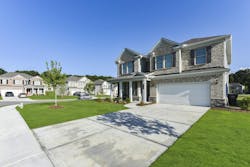Since acquiring its first build-for-rent development less than two years ago, Haven Realty Capital now owns a portfolio of 26 single-family rental communities in eight states—with a value of about $800 million.
A real estate investment and management company based in the Los Angeles area, Haven planted the seeds for its current rapid growth over a decade ago.
Build for Rent Communities Present Investment Opportunity
During the Great Recession, Sudha Reddy, Haven’s founder and managing principal, spotted an investment opportunity. After working in private wealth management and equity research on Wall Street, Reddy had returned to his native Los Angeles and taken on the daily management of his family’s multifamily properties. In 2010, as houses sold at discount prices, Reddy founded Haven Realty Capital to acquire and renovate single family homes, then rent and manage them.
For its first five years, Haven focused on single-family rentals. In 2015, Haven added multifamily rentals to its business, doing similar work: acquiring apartments, improving them, then renting them.
Haven Realty Capital's Bella View build-for-rent community. Video: Home Drone Films on Vimeo
Meanwhile, deep-pocketed institutional investors had a couple of questions for Haven. When they’re used to making investments of up to $100 million each, how can they invest in individual rental houses to make up a portfolio of that size? And when they’re used to buying single-location assets, like large apartment or office buildings, how can they buy and manage houses across various locations?
Those investors’ questions pointed Haven toward the build-for-rent sector. “We went on a journey, and that journey was to figure out if we could create single-location rental communities,” Reddy says.
Haven started asking builders if they would be interested in constructing communities of homes and selling them to Haven as a single buyer—rather than to hundreds of one-off homeowners. “They said, ‘That sounds too good to be true, but we’d do it,’” Reddy recalls. “We determined there’s a win-win partnership we can have with builders.”
Haven's Approach to Build-for-Rent Housing
Rather than developing and building properties itself, Haven serves as the investor and operator. It forms strong partnerships with builders by helping them manage two common industry challenges—labor issues and volatile construction prices—and by making its offers competitive with what builders could get from individual buyers.
Reddy points to the certainty Haven provides builders by contractually agreeing to acquire an entire project. “We can typically double their pace,” Reddy says of Haven’s speed at acquiring a community, compared to selling it to individuals.
Haven also has learned the importance of flexibility. “As construction costs have seen violent swings,” Reddy says, “we realized we need to be able to carry some of builders’ risk alongside them to get projects built.” So Haven contractually shares some of the supply chain risk, rather than leaving builders to shoulder all of it themselves. “It’s about having a willingness to truly partner with builders,” he says.
Haven has located most of its build-for-rent communities, now in various stages of construction, in the Southeast and Southwest. “The reality is there’s a lack of housing supply in just about every area of the country,” Reddy says. But the Southern corners share three concurrent advantages: job growth, population growth, and the need for affordable housing. “The demand is strong, so we’re not begging for tenants,” Reddy says.
Haven Realty Capital's The Reserve build-for-rent community. Video: Home Drone Films on Vimeo
Aside from location, Haven distinguishes its properties with quality, Reddy says: “We rent for-sale homes. We don’t rent rental homes. Our communities look and feel like they’re homeowner communities.”
Typically comprising about a hundred properties, a Haven community has homes of three or four bedrooms and two or three bathrooms, ranging from about 1,800 to 2,400 square feet. The developments boast amenities such as clubhouses, playgrounds, swimming pools, and tennis courts.
Reddy describes Haven’s consumers as “renters by choice.” These aren’t people who rent because they can’t afford to buy, he says. Their households each typically make over $100,000 a year. For them, Haven’s rents of around $2,000 a month, for an owner-quality home, are simply a good deal.
“The number one reason someone moves out of our homes,” Reddy says, “is to buy a house.” Still, he rejects the common conception that renters are would-be buyers who just can’t afford to purchase.
“It isn’t as if our renters are priced out of the [for-sale] market. In a lot of cases, they want to rent,” Reddy says. “This is an opportunity for them not to have to buy a house when they don’t want to.”
Check out more build-for-rent housing trends coverage from Utopia editors:
The single-family build-for-rent market draws big investors
Tracking the Build-for-Rent Housing Boom
What Should Build-to-Rent Communities Look Like?
Why Build-to-Rent is the Hottest Thing in Home Building
5 Ways To Make Distinctive Build-to-Rent Housing Units
Scope of the Single-Family Rental Housing Market
Best Practices for Getting into the Build-to-Rent Housing Business
Startup Creates Investment Opportunities in Single-family Home Rentals
Tricor Embarks on Workforce Build-to-Rent Project in West Dallas
